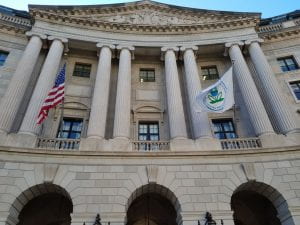In the US, the rising obesity rate and obesity-related comorbidities, such as cardiovascular diseases and Type-II diabetes, have drawn health geographers’ attention. It is generally understood that the lack of access to healthy food provisioning, such as grocery stores selling fresh fruits and vegetables, is driving this obesity crisis. Under this context, the US Department of Agriculture (USDA) Economic Research Service (ERS) develops an inquiry tool, the Food Access Research Atlas (1), generally known as the “food desert locator,” to highlight areas with both low-income and limited access to grocery stores. The tool also incorporates other variables, such as car-ownership, to identify communities at risk of food insecurity.

“Food deserts” identified by the USDA Food Access Research Atlas (1)
This spatial approach, however, has raised questions about the etiology of obesity. It has been found that the correlation between healthy food access and healthy diets is not statistically consistent and is somewhat insignificant (2). In order to articulate the health effects of the community food environment, health geographers argue that other non-spatial variables need to be considered. One such variable is time.
Time shapes food access in two dimensions. On the one hand, the time component, or “temporality,” manifests in the urban food system (3) — grocery stores have different opening hours, farmers’ markets operate in different seasons. For example, it is found that grocery stores in downtown Columbus, Ohio, although there are many of them, close relatively early than stores located in the suburb. This disparity in space-time access to food is visualized by a 3D Geographical Information System (GIS) (4). The plentiful spatial access but limited temporal access could be explained by the store type (e.g., mostly privately owned) and the relatively high crime rate in the downtown neighborhood. Since downtown stores have limited operating hours, local residents may restrict their food choices and could be subject to diet-related health consequences. On the other hand, time shapes individuals’ mobility to procure food. People burdened with multiple social roles, such as childcare while raising an income, may find themselves less available to procure healthy food (5). A study using a travel diary survey identifies that the difference in time use exists between genders and among different races. Full-time employed women and African Americans are at the disadvantage of having less discretionary time (6). The lack of time may victimize these vulnerable social groups and expose them to food insecurity.

A 3D visualization of space-time food access in Columbus (4)
Thus, food access is not only a spatial issue but also a temporal issue. Employing a spatial approach alone to evaluate food access is insufficient. Other tiers of non-spatial variables, such as time, should be factored in to produce knowledge about food access equity and justify the health effects of community food environments.
Xiang Chen is an Assistant Professor in the Department of Geography, University of Connecticut, USA. He received a Ph.D. in Geography at The Ohio State University (2014). His research is focused on GIScience, community health, and food accessibility.
- https://www.ers.usda.gov/data-products/food-access-research-atlas/go-to-the-atlas.aspx
- Caspi, C. E., Sorensen, G., Subramanian, S. V., & Kawachi, I. (2012). The local food environment and diet: A systematic review. Health & Place, 18(5), 1172-1187.
- Widener, M. J., & Shannon, J. (2014). When are food deserts? Integrating time into research on food accessibility. Health & Place, 30, 1-3.
- Chen, X., & Clark, J. (2016). Measuring space-time access to food retailers: a case of temporal access disparity in Franklin County, Ohio. The Professional Geographer, 68(2), 175-188.
- Rose, D., & Richards, R. (2004). Food store access and household fruit and vegetable use among participants in the US Food Stamp Program. Public Health Nutrition, 7(8), 1081-1088.
- Kwan, M. P. (2002). Feminist visualization: Re-envisioning GIS as a method in feminist geographic research. Annals of the Association of American Geographers, 92(4), 645-661.
